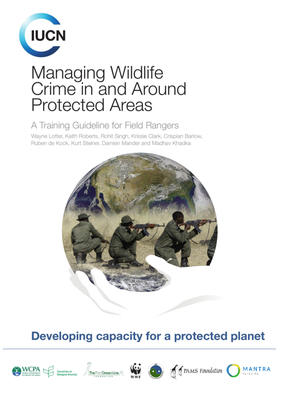Managing Wildlife Crime in And Around Protected Areas: A Training Guideline for Field Rangers

A training guideline produced by IUCN that provides a benchmark of best practices for field ranger trainers, which “covers the basics of operations and the tactics required for them to successfully carry out anti-poaching and operations in the field.
Key Points in Document:
- A training guideline produced by IUCN that provides a benchmark of best practices for field ranger trainers, which “covers the basics of operations and the tactics required for them to successfully carry out anti-poaching and operations in the field. The standard will ensure that anti-poaching training manuals for field rangers may adequately introduce the concepts of law enforcement, tracking, teamwork, conservation and first aid, as well as court procedures to the field ranger.”
- Content for the guide was compiled from consultations with experts and protected area managers.
- The target audiences for this guide are field rangers, protected area managers and agencies, and training providers in all areas where anti-poaching work is required.
- The guide is intended to assist in developing field ranger training materials and “to improve the effectiveness and safety of field ranger work when conducting anti-poaching patrols and associated activities related to the protection of wildlife and natural resources.”
- The guide describes “how to improve job effectiveness and safety for field rangers who work in protected areas in which the illegal harvesting, poaching and trade of natural resources occurs and needs to be controlled.” The publication will provide a best practice benchmark on the scope, details and standard of training that syllabi should cover in order to effectively equip field rangers, who are required to control wildlife poaching, to be able to perform their jobs as proficiently and safely as possible.”
- Major topics covered in this guide includes modules on:
- “Policy, Principles and Philosophy,” which includes ethics, criminal threats, roles and responsibilities, human rights, and conservation and ecology concepts.
- “Mental and Physical Fitness,” which includes drill, discipline, musketry, and physical training.
- “Field Craft,” which includes equipment use and maintenance, concealment, navigation, and tracking.
- “Legal,” which includes wildlife protection legislation, court procedure, evidence, witnesses, and arrest procedures.
- “Operational Enforcement Skills,” which includes patrols, surveillance, night operations, crime scene response, identification of wildlife products, interviewing and interrogation techniques, and joint operations with other enforcement agencies.
- “Monitoring and Record Keeping,” which includes debriefing, reports, and data collection.
Citation: Lotter W, Roberts K, Singh R, et al. Managing Wildlife Crime in and Around Protected Areas: A Training Guideline for Field Rangers (Draft); 2016.

